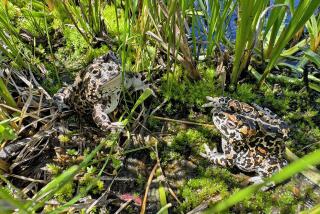Toads, You Have Six Months to Hop to It
- Share via
On most days, the news is not especially good for toads.
Humans step on them, often maiming or crushing them. Or, big RVs rumble over them with the same inevitable result. Or, one more stream is closed, diverted, cemented or deepened--all of which makes a toad’s survival in its natural habitat a major challenge.
In short, try to remember the last time you read something about which a toad could truly rejoice.
That all changed this week when the U.S. Forest Service dropped a bombshell that will upset Orange County recreation-lovers but cause the party to start wherever toads gather.
The service announced that two popular tourist areas in the Cleveland National Forest would be closed all summer to protect the Southwestern arroyo toad from further decimation.
The areas, the Maple Springs-Silverado Canyon Road and the Lower San Juan picnic area, are popular venues for vehicles and hikers. That means lots of big tires and heavy hiking boots, either of which can be detrimental to a toad’s piece of mind, if not its life expectancy. Especially for the arroyo toad, which is small enough to fit in a person’s hand.
And so, says Forest Service biologist Mary Thomas, the toads finally have caught a break. From April through September, the road and picnic area will be off-limits to humans. Toads in the area will be free to do whatever they want, without fear. I ask Thomas if any recent news could possibly rival this for sheer beneficial impact to toads. Short of enhancing the male-female ratio in those areas, Thomas says, she couldn’t come up with anything.
“Think about the toad sitting out there, and man has come along and put in this concrete water crossing,” Thomas says, “and the toad is able to sit up on it and sun itself. What it’s done in the past is either dodge footsteps or horse hooves, mountain bikes or some sort of vehicle.
“Imagine yourself a toad and if you’re going to survive, you have to learn to do that. Imagine sitting there, with your buddies next to you, lazing around in midafternoon, when all of a sudden--’What’s that thing coming at us!’--It’s a big rig and you look around, and guess who’s missing?”
Everyone Out of the Pool
Not a pleasant thing to ponder, but that is, indeed, what toads face every day. The arroyo toad used to flourish all the way from Baja to Monterey, where they could be found in most every stream or creek. Now, Thomas says, perhaps a handful of streams can be called home.
The toad went on the endangered species list a couple of years ago, but the Forest Service was a bit lax in protecting it. This summer, it will make up for lost time.
“What they require in habitat has simply diminished,” Thomas says. “They kind of like areas where it’s a little sandy, it’s open, and when they get ready to lay their eggs, the water is kinda shallow.”
After the eggs hatch and the tadpoles begin to develop, they still hang out in shallow water, usually 2 feet or less. In fact, Thomas says, the entire phase from tadpole to “juvenile toad stage” is spent in these shallow pools.
By the time they lose their tails and get their feet, the toads start spending more time on nearby rocks. But what’s happened is that man has altered the streams and goofed up the toads’ entire lives.
As a result, their numbers have dropped, although Thomas says she’s not sure to what extent.
Toads eat red ants and may have some other value to the ecosystem that humans aren’t aware of, Thomas says. And while they clearly are not the brainiest or most attractive member of the animal kingdom, they deserve a chance in nature.
“Their value to the ecosystem can be something that we aren’t necessarily capable of measuring,” Thomas says. “It may be that they provide a food source we’re not aware of. It bothers me as a scientist that they’re going extinct, because I think we’re rushing the process and because nature isn’t recovering fast enough.”
The summer closures will, in effect, put nature back in charge of the toads’ lives.
At minimum, Thomas says, the toads’ courtship-and-breeding cycle can now proceed apace.
“The male goes out at night and sings his little heart out, trying to attract his lady fair,” Thomas says. “She comes along, they get together, and the next thing you know you’ve got hundreds of little eggs.”
That’s a beautiful image, and you don’t have to be an environmentalist to realize how getting squashed underfoot by an unwitting hiker would ruin the whole experience.
I wouldn’t be surprised if 2000 doesn’t go down in arroyo toad lore as the Summer of Love.
*
Dana Parsons’ column appears Wednesday, Friday and Sunday. Readers may reach Parsons by calling (714) 966-7821 or by e-mail to dana.parsons@latimes.com
More to Read
Sign up for The Wild
We’ll help you find the best places to hike, bike and run, as well as the perfect silent spots for meditation and yoga.
You may occasionally receive promotional content from the Los Angeles Times.






